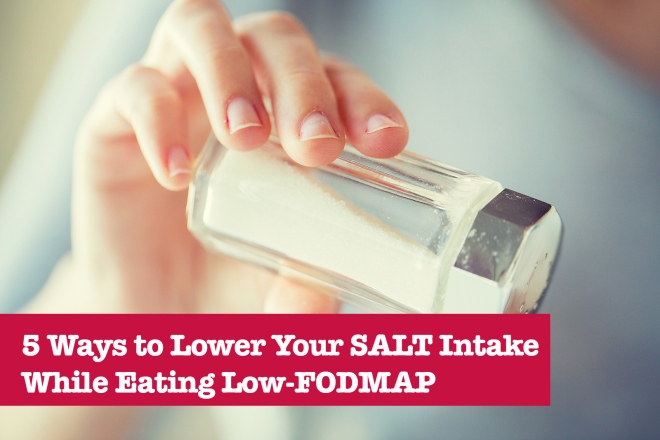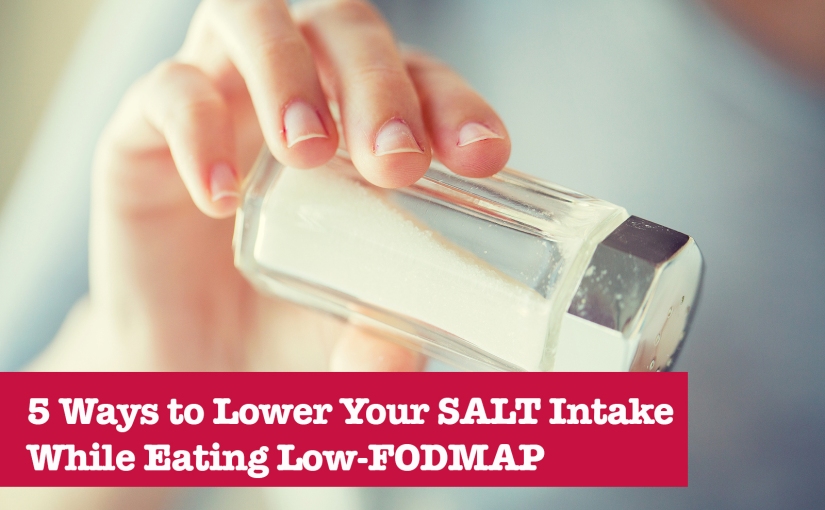
Those following a Low-FODMAP diet may cringe at having to restrict their diet even further, however eating less sodium is very important for good health.
About 90% of Americans consume too much sodium according to the Centers for Disease Control & Prevention (CDC), increasing their risk of high blood pressure. Americans consume about 3,400 mg of sodium each day, and the majority of sodium eaten is already present in foods before purchase or preparation.
Over 3 / 4 of our sodium intake is from processed foods. It turns out that very little of our sodium intake comes from the salt shaker – only about 6%. Since most of our salt intake comes from processed and packaged foods, below are some key methods for how to reduce this major source of sodium (often the hidden sodium) in our diets:
- Eat fewer processed and prepared foods and more whole foods. Bread/Crackers are one of the main sources for sodium in a typical American diet. You want to carefully check the sodium counts per serving on all nutrition labels, especially Gluten-Free foods.
- Eat less or moderate amounts of cheese. Cheese tastes good, however lactose is a FODMAP and can cause problems when too much is consumed (even of an allowed cheese).
- Check sodium amounts and add them up. You may think that you are not eating a lot of sodium, however when you total up the amount per meal and per day you may be surprised at how much you are eating!
- Look for Low-Salt versions of Low-FODMAP foods. *Look for low-sodium versions of deli meat such as Low-Sodium Turkey Breast because deli meat often has a lot of sodium. Buy chicken stock with “No Added Salt” while also free of onion/garlic (to be free of FODMAPs) because canned/boxed soups have a lot of sodium (Swanson’s makes one in the USA ). Look for “No Added Salt” Tuna Fish because canned fish often is high is sodium (Trader Joe’s makes a good one).
- Use salt-free, low-FODMAP herbs/spices (fresh are best) liberally to add flavor. Start an herb garden inside or outside for a continuing supply of herbs/spices such as green onion tops, rosemary, basil, thyme, dill, oregano, spearmint/peppermint, sage, etc. Adding flavor without salt is easy if one takes the time to find and use low-salt or salt-free low-FODMAP herbs/spices. Using infused oils such as garlic-, shallot-, or truffle-infused oil are great ways to add flavor without salt and you only need a small amount to add flavor without FODMAPs (fructans are not soluble in oil and should not cause FODMAP-related issues).
A low-sodium recipe from my website (SalTrax.com) and adapted for Low-FODMAP:
Flavorful Low-Sodium and Low-FODMAP Chicken Soup
Servings: 8
Ingredients:
- 1 whole chicken or cut up parts
- 8 c. cold water
- 1 c. celery, large slices
- 1 c. carrots, whole
- 1 tsp. garlic-infused oil
- 1 tsp. shallot-infused oil
- Parsley, bunch (and/or other fresh herbs of your choice)
- 1/4 tsp pepper or 3-4 peppercorns and 2 tsp. table salt – divided
Directions:
- Place chicken or chicken parts in a large dutch oven.
- Add cold water and rest of the ingredients except for salt; bring to a boil.
- Simmer for 2 hours.
- Add 1 tsp salt halfway through cooking and 1 tsp at end of cooking.
- Remove chicken and vegetables from broth and refrigerate broth overnight.
- Remove hardened fat from surface on next day and remove bones and skin from chicken and discard. Remove and discard any overcooked mushy vegetables.
- Refrigerate meat and vegetables.
- Next day, add chicken and vegetables to the broth after fat is skimmed off.
*Optional: add fresh quartered potatoes or cooked rice (uncooked rice absorbs too much of the chicken broth); sliced celery, sliced carrots, and parsley to the soup. Boil and simmer until vegetables are tender (30 -45 min). Serve warm
Resources for more information about eating a low-sodium diet:
Centers for Disease Control & Prevention (CDC)
National Salt Reduction Initiative (NSRI)
My book: How to keep track of your salt intake: Easy as 1 – 2 – 3

A bit about me: After years of digestive troubles, I became very ill five years ago and was finally diagnosed with Fructose Malabsorption by an astute allergist. In the past five years it has been quite the journey of learning what foods my body can tolerate and which ones throw me into horrible symptoms. I seem to be holding my own now following the Low Fodmap diet; I eat gluten-free, low-sodium, and dairy-free in addition to pretty strictly following the diet. Since going dairy-free a year ago, my frequent migraine headaches are gone. Before I knew dairy was the culprit I wrongly thought that I couldn’t tolerate tomatoes or carrots. I now am able to eat a small amount of tomatoes and carrots which is wonderful. I especially enjoy eating them when they are fresh from the Farmer’s Market.
Colleen and I had met online several years ago through one of the Facebook Low-Fodmap support groups, however due to various scheduling conflicts we had not had the chance to meet. Finally meeting Colleen in person recently at the annual San Diego Gluten Free / Allergy Free Expo was a real treat.
